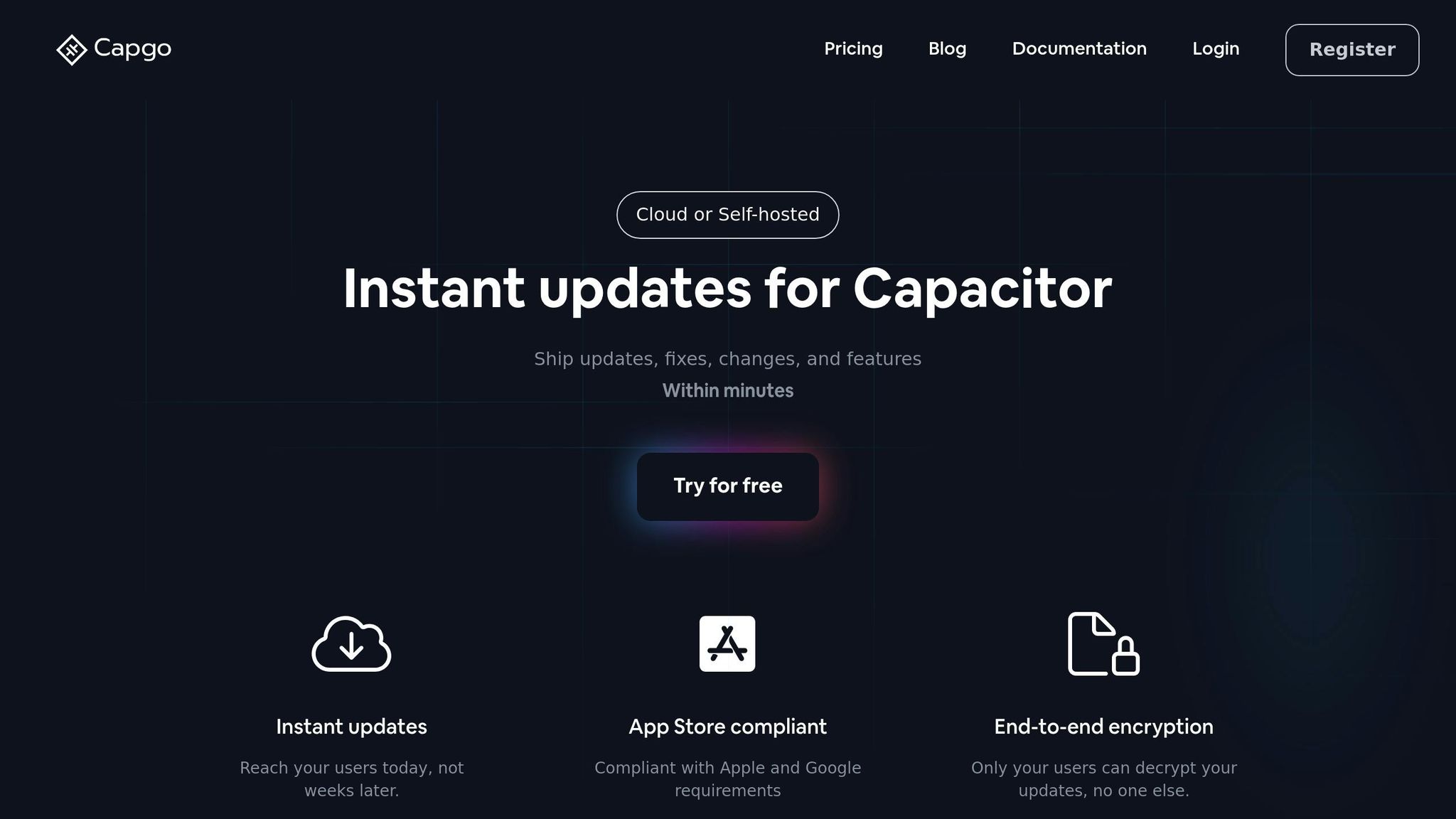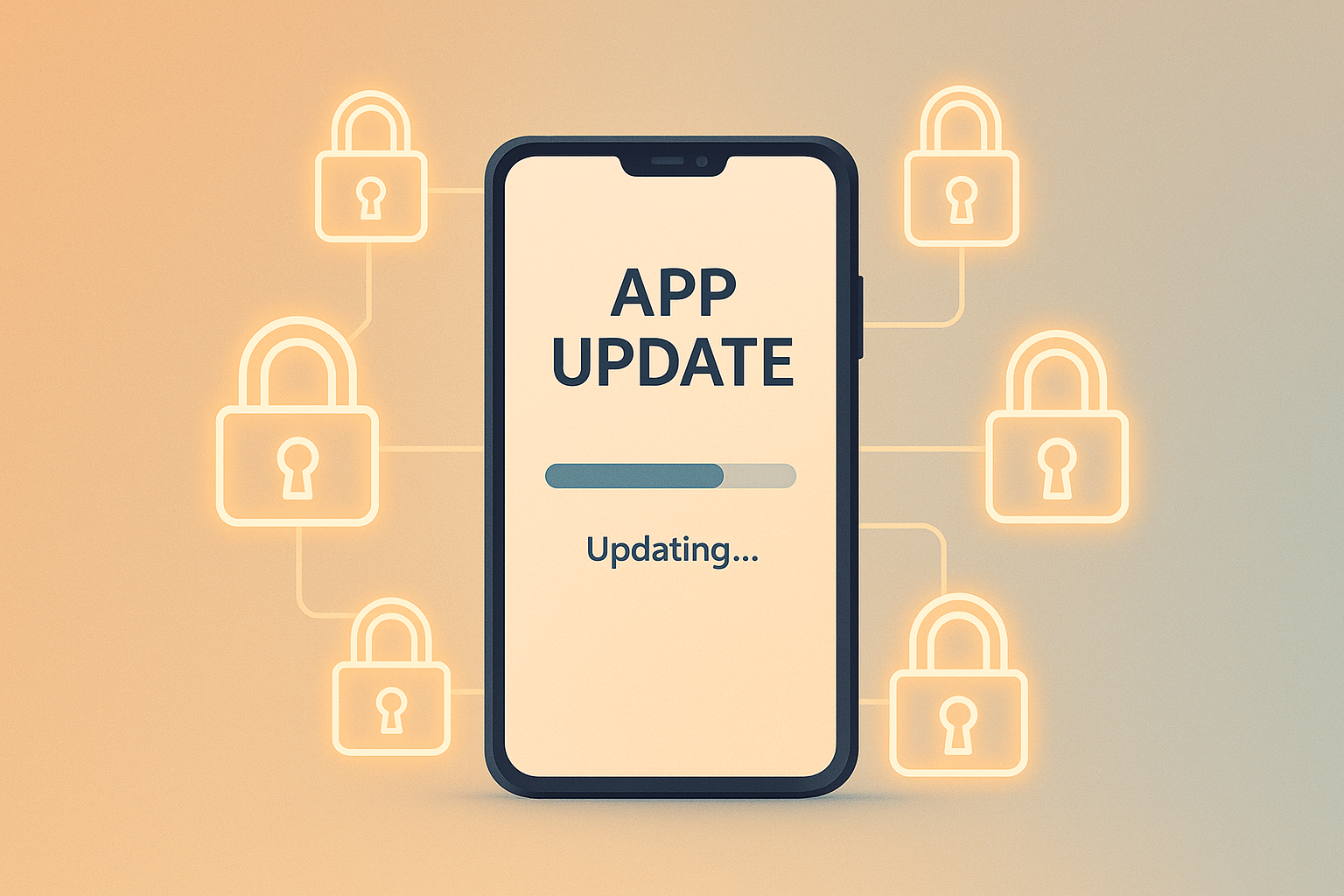OTA (over-the-air) updates allow app developers to deliver changes directly to users without waiting for app store approvals. This speeds up bug fixes, security patches, and feature rollouts. 95% of users install updates within 24 hours, but the fast pace can introduce risks if not managed securely.
Key Points:
- Benefits: Immediate fixes, faster feature releases, consistent app versions.
- Risks: Vulnerabilities like code injection, interception, or weak authentication.
- Security Measures: End-to-end encryption, strong authentication, rollback functionality, and compliance with app store guidelines.
Quick Comparison of App Store Requirements:
| Security Aspect | Apple App Store | Google Play Store |
|---|---|---|
| Code Integrity | Signed binary verification | APK signature verification |
| Update Delivery | HTTPS encryption mandatory | TLS 1.2+ required |
Platforms like Capgo provide tools to ensure compliance, offering features like encryption, CI/CD integration, and rollback support. Choosing a secure OTA platform is essential for protecting users and maintaining app store compliance.
Sending Over-the-Air (OTA) Updates with EAS Update | Step …
Security Risks in OTA Updates
OTA updates can introduce risks that compromise user safety and regulatory compliance. Addressing these risks requires a clear understanding of potential vulnerabilities.
Attack Points
The dynamic nature of OTA updates opens up several weak points that attackers might exploit. Here are some common vulnerabilities:
| Attack Vector | Risk Description | Impact Level |
|---|---|---|
| Code Injection | Malicious code added during the update process | Critical |
| Man-in-the-Middle | Updates intercepted and altered during transmission | High |
Capgo mitigates these risks by using end-to-end encryption to maintain code integrity [1].
These vulnerabilities don’t just pose individual risks - they can lead to large-scale security issues.
Mass Exploitation Concerns
OTA update systems have the potential to affect a massive number of users simultaneously. A few key risks include:
- Updates can be distributed to thousands of devices at once.
- If compromised, updates can execute harmful code across all affected devices.
- Traditional app store security measures might be bypassed entirely.
The speed and scale of OTA deployments can significantly amplify the damage caused by a breach.
Update Authentication Issues
Ensuring secure updates also depends on robust authentication methods. Weak authentication can allow attackers to inject harmful updates into the process. Some common challenges include:
| Challenge | Security Implication |
|---|---|
| Signature Verification | Ensures updates are cryptographically signed for validity |
| Access Control | Protects developer credentials from being compromised |
| Version Control | Maintains the proper sequence and integrity of updates |
To address these challenges, many solutions now implement end-to-end encryption alongside strict authentication protocols, ensuring a safer OTA update process.
App Store Security Rules
Apple and Google enforce strict security measures to protect OTA (over-the-air) update processes.
Apple and Google Requirements
App stores require OTA-enabled apps to follow specific protocols to ensure code integrity and secure updates. Here’s a comparison:
| Requirement | Apple App Store | Google Play Store |
|---|---|---|
| Code Integrity | Signed binary verification | APK signature verification |
| Update Delivery | HTTPS encryption mandatory | TLS 1.2+ required |
Developers must use both digital signing and secure servers to distribute updates. Compliance means maintaining secure channels throughout the entire update process.
Non-Compliance Effects
Failing to meet these requirements can lead to serious issues:
- Immediate Impacts: Non-compliance may result in app removal during audits, disrupting operations and damaging credibility.
- Long-term Consequences: Repeated violations could lead to stricter penalties, making future app submissions more difficult.
- User Trust Impact: Users may lose confidence in a developer’s ability to deliver secure updates, harming the developer’s reputation.
These risks highlight the importance of adhering to app store security rules.
Security Scanning Steps
Developers can reduce non-compliance risks by implementing thorough scanning at every stage of the update process. Here’s how:
| Scanning Phase | Essential Actions | Verification Method |
|---|---|---|
| Pre-deployment | Check code integrity | Automated testing |
| Update Package | Verify digital signatures | Certificate validation |
| Runtime | Perform dynamic security checks | Real-time monitoring |
Capgo ensures compliance by offering “App Store compliant” solutions [1], featuring end-to-end encryption and advanced security protocols.
Regular audits of OTA update systems against current app store guidelines are essential for maintaining compliance and avoiding app rejection.
Security Best Practices
Ensuring secure OTA updates requires a mix of technical measures and well-defined procedures.
Data Protection Methods
A key element of secure OTA updates is end-to-end encryption, which safeguards update packages from the developer to the end-user device.
| Protection Layer | Security Measure | Purpose |
|---|---|---|
| Transmission | HTTPS/TLS 1.2+ | Protects data during transfer |
| Storage | End-to-end encryption | Blocks unauthorized access |
| Verification | Digital signatures | Confirms the integrity of updates |
“The only solution with true end-to-end encryption, others just sign updates” [1]
Additionally, a controlled release process can help reduce potential risks.
Controlled Release Process
To manage updates securely and effectively, follow these steps:
- Phased Distribution: Start with a small group of users, then expand gradually based on performance data.
- Real-time Monitoring: Track update success rates, error logs, and user engagement for any irregularities.
- Rollback Preparation: Always have signed and encrypted backup versions ready for quick rollbacks if needed.
Capgo Platform Features

A reliable OTA update platform incorporates these practices to secure and simplify deployments. Look for platforms offering essential security features.
| Feature | Security Benefit |
|---|---|
| End-to-end encryption | Protects updates from unauthorized access |
| CI/CD integration | Automates and simplifies the deployment process |
| Channel system | Supports controlled beta testing and gradual rollouts |
| Analytics dashboard | Monitors update performance in real time |
| Rollback support | Allows instant reversal in case of issues |
For enterprise users, Capgo offers CI/CD setup services priced at $2,600 [1], ensuring your security framework is correctly configured from the start.
OTA Platform Comparison
When evaluating OTA update platforms, it’s essential to consider stability, security features, and long-term support. The closure of Microsoft CodePush in 2024 and the upcoming shutdown of Appflow in 2026 underscore the importance of choosing a reliable solution. This comparison highlights how strong security measures and consistent support set leading OTA platforms apart.
Platform Features Matrix
| Feature | Capgo | Appflow | CodePush | | --- | --- | --- | --- | --- | | Active Status | Operating since 2022 | Operating since 2024 | Closing 2026 | Closed 2024 | | End-to-End Encryption | Yes | No | No | No | | Update Success Rate | 82% worldwide | N/A | N/A | N/A | | User Update Speed | 95% within 24h | N/A | N/A | N/A | | Global CDN Speed | 114ms (5MB bundle) | N/A | Varies | N/A | | Self-Hosting Option | Yes | Limited | No | No | | CI/CD Integration | Yes | Basic | Yes | No | | App Store Compliance | Full | Partial | Full | Limited | | Monthly Active Users | Scalable to 1M+ | Limited | Enterprise | N/A |
Selecting the right OTA platform is crucial for ensuring app store compliance and maintaining secure, efficient operations. Modern platforms now integrate advanced security features with dependable, long-term support.
“We are currently giving a try to @Capgo since Appcenter stopped live updates support on hybrid apps and @AppFlow is way too expensive.”
– Simon Flack [1]
Costs for OTA platforms can vary widely, with CI/CD operations ranging from $300 per month to $6,000 annually [1].
“Cancelled my @Appflow subscription after 4 years. Code-Push never seemed to work well, hopefully @CapGO has it figured out.”
– LeVar Berry [1]
With 1.4K apps in production relying on these solutions, it’s clear that the market values platforms that prioritize security and reliability [1].
Conclusion
The security measures and platform insights covered earlier highlight the importance of well-rounded OTA (over-the-air) update strategies. Industry data underscores the need for precise security controls alongside efficient deployment capabilities [1].
Today’s OTA platforms have advanced to tackle key security challenges while meeting strict app store standards. This progress addresses earlier risks and ensures compliance with app store requirements. Effective solutions combine strong security frameworks with smooth update processes, leading to high success rates and widespread user adoption [1].
“The community needed this and @Capgo is doing something really important!” - Lincoln Baxter [1]
Security practices have become an industry standard, with end-to-end encryption now a must-have feature. The transition from older update methods to secure OTA platforms allows developers to uphold strong security measures while delivering updates more effectively.
Here are some critical security elements and their role in app store compliance:
| Security Aspect | Impact on App Store Compliance |
|---|---|
| End-to-End Encryption | Protects data integrity during transit |
| Update Authentication | Blocks unauthorized updates |
| Rollback Capability | Offers quick fixes for security issues |
| Error Tracking | Supports app stability and security |
Modern OTA platforms prove that security and efficiency can go hand in hand. Balancing these two priorities is vital for maintaining compliance and earning user trust in today’s app-driven world [1].
FAQs
::: faq
What risks do OTA updates pose to app security, and how can developers address them?
OTA (Over-The-Air) updates can expose apps to potential vulnerabilities, such as unauthorized access or compromised data integrity, especially if updates are not properly secured. These risks can impact app store compliance and user trust.
To mitigate these risks, developers should implement robust security measures like end-to-end encryption, regular testing, and secure deployment practices. Tools like Capgo can help streamline this process by enabling instant updates for Capacitor apps without requiring app store approvals. Capgo’s features, such as seamless CI/CD integration and user-specific update assignments, ensure updates are both secure and compliant with Apple and Android standards. :::
::: faq
How do OTA updates help maintain app store security compliance, and what happens if compliance is not met?
OTA (Over-The-Air) updates play a crucial role in maintaining app store security compliance by allowing developers to quickly deliver updates, bug fixes, and new features without waiting for lengthy app store approval processes. This ensures that apps stay secure and up-to-date with the latest requirements from Apple and Android.
Failing to comply with app store security standards can lead to serious consequences, such as apps being removed from the store, loss of user trust, or even legal penalties. Solutions like Capgo make it easier to manage OTA updates while adhering to all compliance requirements, offering features like end-to-end encryption and seamless integration with development workflows. :::
::: faq
What key features should developers prioritize in an OTA platform to ensure secure and seamless app updates?
To ensure secure and seamless app updates, developers should prioritize features like end-to-end encryption, integration with CI/CD pipelines, and the ability to assign updates to specific user groups. These capabilities help safeguard app data, streamline the update process, and provide greater control over who receives updates.
For example, platforms like Capgo are designed to meet compliance requirements for both Apple and Android, offering real-time updates without the need for app store approval. By focusing on security, efficiency, and compliance, developers can confidently deliver updates while minimizing risks. :::




